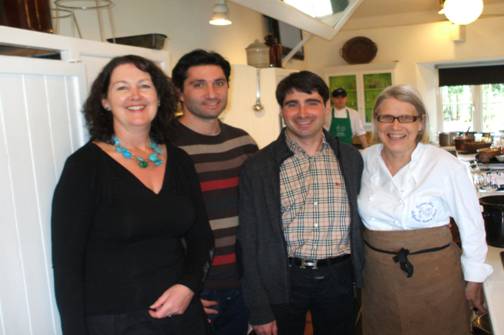Jon Moslet, one of the students on the 12-week certificate cookery course, gave two fantastic wine presentations, along with Marco, to his fellow students on wines – the first one on wines from Colli Orientali del Friuli. This was a great opportunity for all to taste some unique and fascinating wines and grape varieties from Ronchi di Cialla (in DOC Colli Orientali del Friuli, Italy), and the second presentation on wines from Sicily was equally fascinating featuring the wines from Barone di Villagrade and from COS.
The wines from Colli Orientali del Friuli.
The wine producer RONCHI DI CIALLA, http://www.ronchidicialla.it (visits by appointment), run by the Rapuzzi family and located in the gentle hills of “Colli Orientali del Friuli” close to the border of Slovenia in North-Eastern Italy, is unique in many respects in the annals of modern Italian winemaking.
RONCHI DI CIALLA does not produce more than 60,000 bottles of wine per year, but through their consistent work with local grape varieties and perservering method and passion for quality, the Rapuzzi family has been an important innovator recognised in wine circles throughout Italy.
In the verdant hills between the Austrian alps to the north and the Adriatic Sea to the south, in a climate fostering oak and pine trees as well as olive groves, a range of particularly interesting vines have developed and adapted over the millennia. The indigenous varieties of Refosco, Schioppettino, Ribolla Gialla, Picolit og Verduzzo, know and treasured for centuries, are now having their renaissance, not least because of the effort of RONCHI DI CIALLA:
· The first producer to purposefully use the variety Schioppettino in a high quality wine suitable for ageing. Until RONCHI DI CIALLA saved this grape variety from extinction in 1974, only a few vines remained growing
wild. It is now considered one of the most important grape varieties in the region.
· The first Italian wine producer to use barrique in the vinification of white wines
· One of only a handful of Italian wine producers to resolutely withhold a major part of their production for ageing and subsequent sales. All vintages (1977-2008) are available.
· The “cru” (sottozona) of Cialla was recently established in recognition of RONCHI DI CIALLA’s pioneering work, one among only 2 dozen cru in the Italian DOCG system.
· The establishment of DOCG Picolit (from 2006) also includes Cialla as a cru.
Tasting notes:
Ciallabianco 2007
DOC Colli Orientali del Friuli
65% Ribolla Gialla, 20% Picolit, 15% Verduzzo
Deep straw-coloured white wine, hints of white fruit pear, apple and plum), vanilla and jasmine. Wellbalanced, structured, dry and round.
Fermentation in oak barrels followed by 11 months’ maturation. Further ageing in bottles, from 6 to 12 months.
Can be stored for at least 10 years. Fish and seafood starters; soups (pumpkin); fish served with a sauce; egg and vegetable soufflés (asparagus); white meats with a sauce; delicate cured hams; semi hard cow’s milk cheese.
Cialla Schioppettino 2004
DOC Colli Orientali del Friuli
100% Schioppettino
Ruby hues, spicy fragrances (white pepper) with hints of soft fruit (red berries), elegant while independent and assertive. Dry, soft tannins, pleasant and well-balanced finish.
Aged 18 months in French barriques and at least 30 months in bottles before release. Can be stored for at least 20 years.
Orzo (barley) minestrone (traditional of Friuli); roasted white and red meats; meats with delicate sauces; poultry and small game; mushrooms; Indian cuisine.
Cialla Picolit 2005
DOC Colli Orientali del Friuli
100% Picolit
Crisp golden colour, hints of honey, fresh and dried fruit, “sweet but not sweet”, with dry and exceptionally elegant finish.
Partial desiccation on the vine. 50% of the grapes are subsequently air-dried naturally for 3-4 months, causing the grapes to lose up to 60% of their original weight. Aged 12 months in barriques and at least 18 months in bottles before release. Can be stored for at least 20-25 years.
Great “meditation” wine, but also excellent when served with foie gras or mature cheeses.
Â
Photo attached – Jon, Marco, Samuel and Colm

